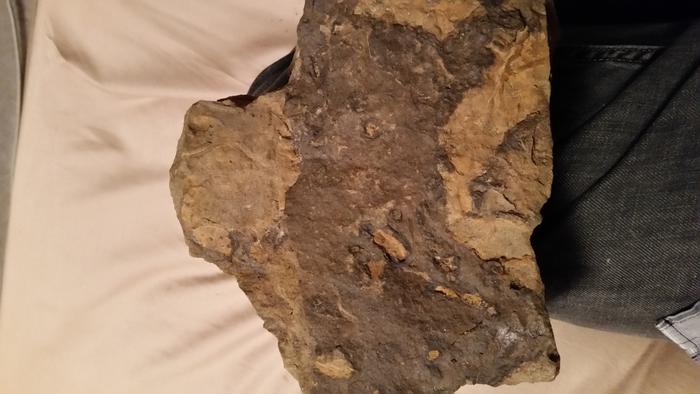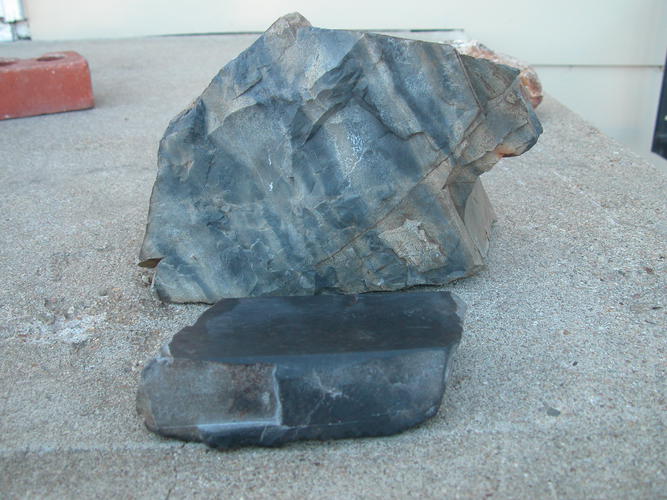Results 631 to 640 of 804
Thread: I Found It Over There
-
10-13-2015, 02:49 AM #631Senior Member




- Join Date
- Feb 2013
- Location
- Haida Gwaii, British Columbia, Canada
- Posts
- 14,450
Thanked: 4829
It's a big saw.
It's not what you know, it's who you take fishing!
-
10-13-2015, 02:55 AM #632Senior Member

- Join Date
- May 2014
- Location
- South East Idaho
- Posts
- 103
Thanked: 24
Just need a welder some bearings and some scrap metal. I have messed with them doing concrete. I think it would be worth it. I might would make a jig so it worked like a bridge saw with a small table.
-
10-13-2015, 03:11 AM #633Senior Member

- Join Date
- Sep 2015
- Posts
- 695
Thanked: 77
I found this in Arkansas, it has all kinds of sparkles showing
 the silica content and I'm not sure exactly what it is but I think its some type of sandstone. One day I'll cut it up. I think it will be around 600 to 700 grit range. Definitely not a good hone but may be a good stone.
the silica content and I'm not sure exactly what it is but I think its some type of sandstone. One day I'll cut it up. I think it will be around 600 to 700 grit range. Definitely not a good hone but may be a good stone.
-
10-13-2015, 03:14 AM #634Senior Member




- Join Date
- Feb 2013
- Location
- Haida Gwaii, British Columbia, Canada
- Posts
- 14,450
Thanked: 4829
I check every sandstone I find. To be honest, they almost always are either very soft and crumbly or do not have an even grit. Mostly fine sandstone with little bits of gravel all through it is more typical. I know there were some sandstones that wound up being good low grit hones so I keep looking at those too. Sooner or later...
It's not what you know, it's who you take fishing!
-
10-13-2015, 03:15 PM #635

It depends how you define hone. Just about any rock will serve in one way or another. There is a reason certain rocks are prized as hones and cost so much. Such stones have the ideal characteristics and that's what you pay for. The higher grit you go for the rarer the material. if you want to do preliminary work on an axe that's easy to find.
If you want to do some prospecting first you need to research reports on known quality hones and see their composition. Then you research your target area and look for similar rock associations and check the local Geologic Maps and use topographic maps to locate the precise areas. Get yourself a rock pick and a few chisels and off you go.
That's how I'd do it. As was mentioned often times the outer surface looks nothing like the actual rock so you need to break the rock open. That's because of weathering. Rocks containing certain minerals undergo chemical reactions which drastically change their appearance. A quartz pebble won't change much but something with iron will for instance.
The first thing I learned in my first Geology Course is no self respecting field Geologist would ever tell you "this rock is" from just looking at the outer surface. Maybe he'll say "it looks like". You need to see the inside and use magnification and tests to be precise.No matter how many men you kill you can't kill your successor-Emperor Nero
-
10-13-2015, 03:55 PM #636Senior Member

- Join Date
- Jul 2013
- Posts
- 444
Thanked: 18
-
11-11-2015, 11:35 PM #637

Here is a new stone that I'm very excited about. The small test piece in the fore ground is from the same deposit. Though the deposit is 700' thick and was layed down over a period of about 10 million years. It would be reasonable to expect some differences in the two samples.

-
11-11-2015, 11:39 PM #638

So what is it?
No matter how many men you kill you can't kill your successor-Emperor Nero
-
11-11-2015, 11:44 PM #639
-
11-11-2015, 11:52 PM #640Senior Member




- Join Date
- Feb 2013
- Location
- Haida Gwaii, British Columbia, Canada
- Posts
- 14,450
Thanked: 4829
I'm pretty excited to see that old rock. The layering is very pretty. What is you plan on getting it into manageable size pieces. Are you going to rent a gas powered concrete cutoff saw? It looks like a hefty chunk. Rock is funny in how and when it decide to change. Hopefully you can get some nice hones out of that.
It's not what you know, it's who you take fishing!


 862Likes
862Likes LinkBack URL
LinkBack URL About LinkBacks
About LinkBacks






 Reply With Quote
Reply With Quote


